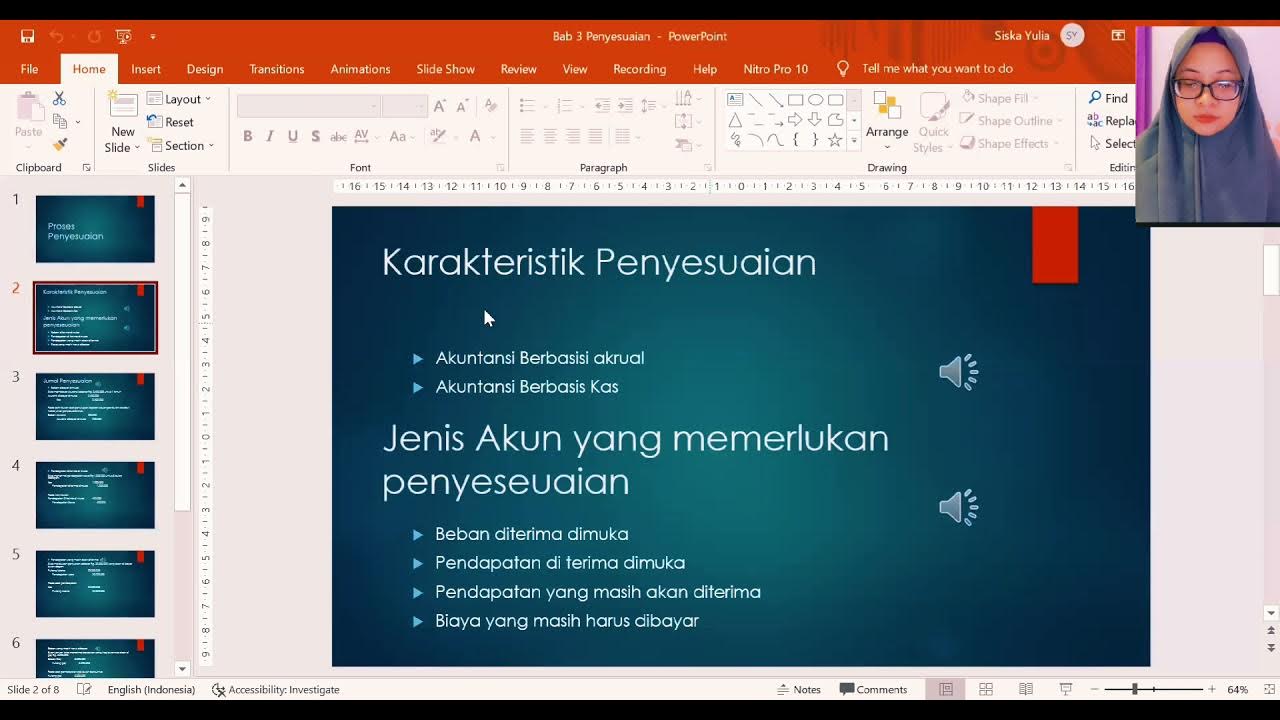Gr 11 Accounting - Adjustments - Activity 2
Summary
TLDRIn this educational video, Mrs. Broomercon discusses income adjustments, focusing on deferred income and accrued income. She explains the accounting treatment for income received in advance, which should be subtracted as it's not part of the current period's income, and accrued income, which should be added as it's due for the current period. The video includes practical examples, such as a customer's unsatisfactory repair service affecting fee income and rent adjustments for a tenant, Mr. Spiderman, including rent increases and repairs offset against the tenant's debt. The session concludes with a motivational quote, encouraging viewers to stay prepared and focused.
Takeaways
- 📚 The session is focused on understanding income adjustments, particularly deferred income and accrued income.
- 💡 Deferred income, also known as income received in advance, must be subtracted from the income account as it does not form part of the current period's income.
- 🔍 Deferred income is classified as a current liability and is part of note number 9, trade and other payables.
- 📈 Accrued income, which is income outstanding for the current accounting period, should be added to the income account and is classified as a current asset.
- 📝 The income account is credited for accrued income, and it forms part of note number 5, trade and other receivables.
- 📉 The accounting equation is affected by these adjustments: a decrease in income affects owner's equity negatively, and an increase in liabilities affects it positively.
- 🔧 Adjustment A involves a customer complaint about repairs, where the fee income is debited and deferred income is credited, reflecting the offset against future fees.
- 🏠 Adjustment B involves rent income from a tenant, Mr. Spiderman, and the calculation of rent for the current accounting period, considering an increase in rent.
- 🛠 Repairs paid by the tenant are considered an expense for the business and are offset against the amount owed by the tenant.
- 📊 The general journal entries are prepared to reflect these adjustments, affecting both the balance sheet and the profit and loss account.
- 💪 The speaker concludes with a motivational quote encouraging preparation, focus, and perseverance.
Q & A
What is the main focus of the activity discussed in the script?
-The main focus of the activity is on income adjustments, specifically looking at income received in advance and accrued income.
Why is income received in advance subtracted from the income account?
-Income received in advance is subtracted because it does not form part of the income for the current accounting period.
What is another term for income received in advance?
-Another term for income received in advance is deferred income.
How is income received in advance classified in the balance sheet?
-Income received in advance is classified as a current liability, which forms part of note number 9, trade and other payables.
What should be done with accrued income in the accounting process?
-Accrued income should be added to the income account as it represents income that is still outstanding for the current accounting period.
How is accrued income classified in the balance sheet?
-Accrued income is classified as a current asset, which forms part of note number five, trade and other receivables.
What is the purpose of preparing journal entries for adjustments?
-The purpose of preparing journal entries for adjustments is to post them to the general ledger and show their effect on the accounting equation.
Can you explain the concept of adjustment number A from the script?
-Adjustment number A involves a cash customer who was dissatisfied with repairs and had paid for a service. Instead of a refund, it was agreed to offset this amount against fees charged in the following month, making it an income received in advance.
What is the situation described in adjustment B, and how does it relate to the accounting period?
-Adjustment B involves a tenant, Mr. Spiderman, who has been renting since the previous financial year. The focus is on the rent income for the current accounting period, which includes an increase in rent and repairs paid by the tenant that need to be offset against the amount owed.
How does the script handle the increase in rent for Mr. Spiderman's premises?
-The script calculates the total rent for 11 months by considering the initial rate for three months and the increased rate for eight months, then adjusting for the outstanding rent after accounting for the repairs paid by the tenant.
What is the final step mentioned in the script for handling the adjustments?
-The final step mentioned is to close off the nominal account section and balance the balance sheet account section, ensuring that all income and expenses are correctly reflected in the profit and loss account.
Outlines

This section is available to paid users only. Please upgrade to access this part.
Upgrade NowMindmap

This section is available to paid users only. Please upgrade to access this part.
Upgrade NowKeywords

This section is available to paid users only. Please upgrade to access this part.
Upgrade NowHighlights

This section is available to paid users only. Please upgrade to access this part.
Upgrade NowTranscripts

This section is available to paid users only. Please upgrade to access this part.
Upgrade NowBrowse More Related Video

Penyesuaian dan Daftar saldo setelah penyesuaian

Gr 11 Accounting - Adjustments - Activity 1

[FABM2] Lesson 037 - Statement of Changes in Equity

Different Measures of National Income I A Level and IB Economics

What Is Adjusted Gross Income?

Contoh Perhitungan PPh Pasal 23 atas Penghasilan Royalti & Penghasilan Sewa
5.0 / 5 (0 votes)